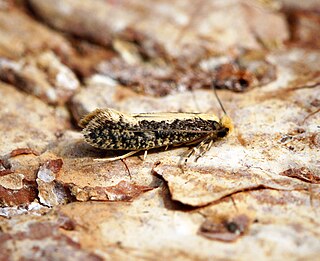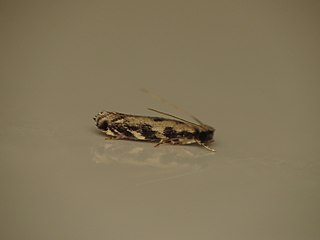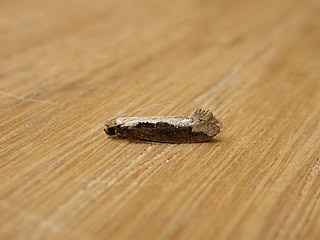
Cryptophlebia ombrodelta, the litchi fruit moth or macadamia nut borer, is a moth of the family Tortricidae. The species was first described by Oswald Bertram Lower in 1898. It is native to India, Sri Lanka, Nepal, Indonesia, China, Taiwan, Vietnam, Thailand, western Malaysia, New Guinea, the Philippines, Japan, Guam, the Caroline Islands, Australia and has been introduced to Hawaii.
Anatrachyntis rileyi, the pink cornworm, pink bud moth or pink scavenger, is a species of moth of the family Cosmopterigidae, the cosmet moths. It was first described by Lord Walsingham in 1882 from the southern United States, but it is probably an introduction to North America. It is found in much of the warm or tropical areas of the world, including northern Australia, the Galápagos Islands, Hawaii, the Antilles, South America and Mauritius.
Thyrocopa abusa is a moth of the family Xyloryctidae. It was first described by Lord Walsingham in 1907. It is endemic to the Hawaiian islands of Kauai, Oahu, Molokai, Lanai, Maui and Hawaii. It is the type species of the genus Thyrocopa.

Monopis crocicapitella, the pale-backed clothes moth, is a moth of the family Tineidae described by James Brackenridge Clemens in 1859. It has a nearly cosmopolitan distribution. It was first described from the eastern United States. It is particularly destructive of fabric and clothes.
Erechthias flavistriata, the sugarcane bud moth, is a moth of the family Tineidae. It was described by Lord Walsingham in 1907 from Hawaii, but is probably an introduced species. It is found in large parts of the Pacific Rim including the Marquesas, Rapa Iti, Fiji, the New Hebrides, the Kermadec Islands, the Solomons, Java and Malaya. It has been spread widely by man and probably has travelled to many islands throughout much of the Pacific in the canoes of the native peoples.
Erechthias penicillata is a moth of the family Tineidae. It was first described by Otto Herman Swezey in 1909. It is found in the Pacific region, including French Polynesia and Hawaii.
Erechthias kerri is a moth of the family Tineidae. It was first described by Otto Swezey in 1926. It is found in the Pacific region, including the French Frigate Shoals, Lisianski, Laysan, the Pearl and Hermes Reef, Johnston Island and Hawaii.

Erechthias simulans is a species of fungus moth. It is here considered to belong to the somewhat controversial type genus of its subfamily Erechthiinae, though even fairly recently some authors have proposed to retain other genera such as Decadarchis separate from Erechthias. Decadarchis, with E. simulans as type species, would in fact contain this moth and its closest relatives, regardless whether it is recognized as full genus or as subgenus. These relatives are generally held to be a group of mainly Polynesian species. E. simulans has also been mistaken for a species of the closely related genus Comodica; while the delimitation of this versus Erechthias/Decadarchis is not universally agreed upon, E. simulans is not included in Comodica anymore by modern authors.

Erechthias zebrina is a fungus moth. Initially, it was mistakenly believed to be an ermine moth of genus Argyresthia.
Opogona purpuriella is a moth of the family Tineidae. It was first described by Otto Swezey in 1913. It has been recorded from Hawaii and Tonga. It has also been reported as a port interception in California.
Opogona aurisquamosa is a moth of the family Tineidae. It has been recorded from the Pacific, including Easter Island, the Marquesas, the Society Islands, Fiji, the Kermadec Islands and Hawaii. It may have been dispersed by the Polynesians as well as by Europeans.

Erechthias diaphora is a moth of the family Tineidae. It is known from Australia, including New South Wales, Queensland and Victoria.

Erechthias ascensionae is a moth of the family Tineidae. It is endemic to Ascension Island.

Erechthias grayi is a moth of the family Tineidae. It is endemic to Ascension Island.

Erechthias darwini is a moth of the family Tineidae. It is endemic to St. Paul’s Rocks, a group of 15 small islets and rocks in the central equatorial Atlantic Ocean. It was first recorded by Charles Darwin.

Erechthias dracaenura is a moth of the family Tineidae. It is endemic to São Tomé Island, an island off the western equatorial coast of Central Africa. The species was described by Edward Meyrick in 1934.

Uromycladium tepperianum is a rust fungus that infects over 100 species of Acacia and related genera including Paraserianthes in Australia, south-east Asia, the south Pacific and New Zealand. The acacia gall rust fungus species Uromycladium tepperianum has been introduced to South Africa as a biological control on the invasive Australian shrub Acacia saligna.
Erechthias beeblebroxi is a moth of the family Tineidae. It is endemic to Australia, where it has been recorded from Queensland.











